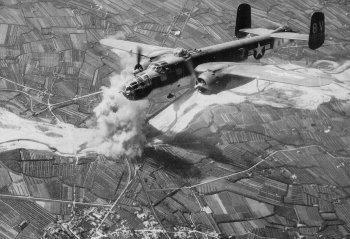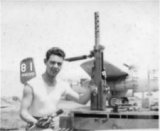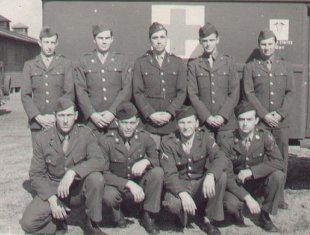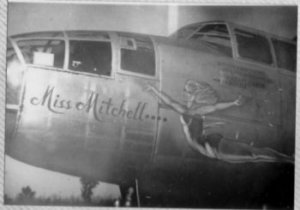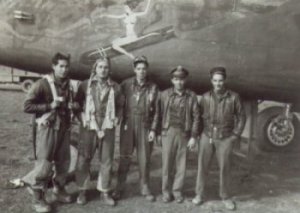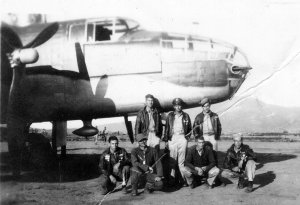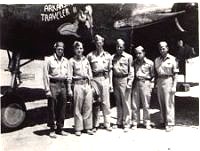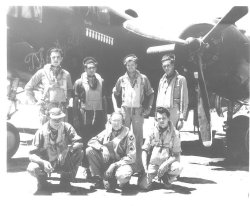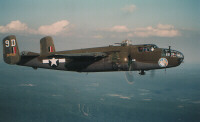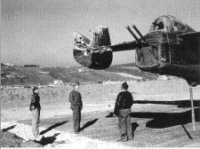|
John F. Koplitz, Pilot, RCAF, RAF and AAF William Fray Livesey, Fighter Pilot History of the 340th. Bombardment Group Nose Art From the 57th. Bomb Wing May 13 1944, Alensa Airfield, Corsica S/Sgt. Jack Washleski, Tail Gunner S/Sgt. Brendon J. Murphy, ROM Gunner
|
One of the most important roles in the Mediterranean theater campaigns was played in aerial warfare by the 57th. Bomb Wing, A command composed of B-25 Mitchell medium bomber. Some of which began their combat history as early as the first landings in North Africa in November 1942. Since that time, the B-25's have participated in every major campaign from Tunisia to the final drive. Click below for more pictures from the 488th. Andrew Lucas - Tail Gunner (right), 340th. Bombardment Group, 488th. Bombardment Squadron
S/Sgt. Brendon J. Murphy,
ROM Gunner The history of the bomb groups under the 57th. Bomb Wing reads in the order of the Mediterranean campaigns. After the North African landings came the battle of Kasserine Pass, a German counter offensive, the failure of which became the turning point of the war. From support of the North African landings, the B-25's flew to attack Axis concentrations and airfields in Tunisia, as well as carry out sea sweeps against enemy shipping. After Tunisia, the Mitchell's concentrated upon the small, heavily fortified Islands of Pantelleria and Lampedusa which threatened any future thrust toward Europe from the South. The aerial campaign against these two Islands resulted in the first surrender of troop solely from air attack without the aid of ground troops.
Captain Benjamin Marino,
M.D. September, 1943, brought Salerno and the hard, steady battle after the initial landings. Operations were directed against communications a short distance from the enemy lines cutting their avenues of support there as well as in the Naples area. By early October, the Mitchell's were operating from new bases in Italy and began their concentrated attacks against targets in the Balkans, resulting in the further destruction of the Luftwaffe. The B-25's also made the first attack of the war on Bulgaria from here. ("Miss Mitchell" 380th Bombardment Squadron)
340th. Bombardment Group,
488th. Bombardment Squadron The same month saw the invasion of Anzio and the unending support given from the air. Then came the unrelenting drive to isolate the Cassino battlefront by the bombardment of German communications in central Italy every day the weather would permit. The B-25's were the first to fly in the all out attack on Cassino. To conduct better the communications campaign, all of the 57th. Wing units were on Corsica, far behind the German lines, in April. From here they reached out across the sea to chop constantly at enemy rail and road links during the allied drive capture Rome. 340th. Bombardment Group, 487th. Bombardment Squadron Sgt. Winthrop Woodward far right This was followed quickly by the destruction of all bridges over the Po River, which paid dividends over nine months later. Corsica as a base proved valuable in the invasion of Southern France. The Mitchell's did some of the most outstanding work of the war against bridges, and gun positions. Attacks on Yugoslavia and even Austria were carried out from those bases. In November came the greatest undertaking medium bombers ever accepted and with amazing success. It was the Battle of Brenner, against the vital rail line between Germany and the Italian battle front. On January 26th, the line was cut or blocked in at least 18 locations, 15 of which had been created by the 57th. Bomb Wing. 321st. Bombardment Group,
446th. Bombardment Squadron Shortly before the final drive in Italy, the 57th. Bomb Wing swiftly moved into Northern Italy and when D-Day came it found them preparing to put the greatest effort ever known on the part of the medium bombers. In April 4.638 sorties were flown in close support of the British 8th., and American 5th. Army troops with attacks on enemy troop concentrations, supplies, defense areas, and communications. It was fitting indeed, when the B-25's flew their final missions - that of dropping leaflets on the enemy announcing the unconditional surrender of the German Armies in Italy. 321st. Bombardment Group, 445th. Bombardment Squadron L-R standing: The B-25 "Mitchell" Medium Bomber Beginning in 1940, almost 10,000
B-25s entered Army and Air Force service, and some 2,000 more went into British, Soviet,
Brazilian and U.S. Marine Corps service. One tough bird! Lt. Col. Jimmy Doolittle's raid on
Tokyo, a psychological victory for Americans, incensed the Japanese, who retaliated by
killing an estimated quarter million Chinese soldiers and civilians. Additional Images; F Koplitz, All rights reserved |
